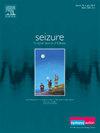Prevalence and patterns of comorbidities in individuals with epilepsy: A nationwide analysis using colombian healthcare registry data
IF 2.7
3区 医学
Q2 CLINICAL NEUROLOGY
引用次数: 0
Abstract
Introduction
Epilepsy is a multifaceted neurological disorder that extends beyond seizure episodes, with substantial comorbidities impacting patients' quality of life. This study quantifies the burden and association patterns of epilepsy-related comorbidities in the Colombian population.
Methods
This descriptive, cross-sectional study analyzed data from the nationwide Colombian healthcare registry (RIPS) from 2019 to 2023. We estimated the prevalence of epilepsy and selected comorbidities including neurological conditions (migraine, multiple sclerosis, stroke, Alzheimer's disease in individuals 65+), psychiatric disorders (depression, major depression, anxiety, schizophrenia), trauma (general and head trauma), and infectious diseases (HIV, neurocysticercosis). Prevalence ratios (PRs) were calculated comparing individuals with epilepsy to those without, with stratification by sex and age groups. Chi-squared tests were conducted to assess statistical significance of differences in prevalence, with p < 0.05 considered significant.
Results
Among 53,785,138 individuals in the Colombian healthcare system, 461,118 were diagnosed with epilepsy (prevalence 8.57 per 1000), with the highest prevalence in older adults (11.37 per 1000 in ages 65+). Neurological comorbidities were common, with migraine present in 6.86 % of epilepsy patients versus 3.89 % in the general population (p < 0.001), multiple sclerosis in 0.152 % versus 0.021 % (p < 0.001), and stroke in 6.04 % versus 0.75 % (p < 0.001). Among psychiatric conditions, depression affected 5.84 % of epilepsy patients compared to 1.87 % in the general population (p < 0.001), while schizophrenia was diagnosed in 4.13 % of epilepsy patients versus 0.41 % in the general population (p < 0.001). Trauma was present in 25.0 % of epilepsy patients compared to 16.4 % generally (p < 0.001), with head trauma specifically in 7.1 % versus 2.5 % (p < 0.001). Neurocysticercosis, though rare overall (0.0064 % in general population), was notably more prevalent in epilepsy patients (0.289 %, p < 0.001). Significant sex differences were observed, with females showing higher prevalence of migraine (9.82 % vs 3.89 % in males) and depression (7.33 % vs 4.34 %) within the epilepsy population, while males had higher rates of schizophrenia (4.81 % vs 3.46 %) and head trauma (8.93 % vs 5.32 %).
Conclusion
This study provides critical insights into the burden of epilepsy-related comorbidities in Colombia, highlighting the importance of targeted interventions. The substantial comorbidity burden demonstrated across neurological, psychiatric, traumatic, and infectious domains underscores the importance of interdisciplinary, patient-centered care approaches that extend beyond seizure control. By addressing these comorbidities through integrated care models, clinicians can significantly improve both health outcomes and quality of life for people living with epilepsy.
癫痫患者合并症的患病率和模式:使用哥伦比亚医疗保健登记数据的全国分析
癫痫是一种多面性的神经系统疾病,其影响范围不局限于癫痫发作,其并发症严重影响患者的生活质量。本研究量化了哥伦比亚人群中癫痫相关合并症的负担和相关模式。方法本描述性横断面研究分析了2019年至2023年全国哥伦比亚医疗保健登记处(RIPS)的数据。我们估计了癫痫的患病率和选定的合并症,包括神经系统疾病(偏头痛、多发性硬化症、中风、65岁以上个体的阿尔茨海默病)、精神疾病(抑郁症、重度抑郁症、焦虑症、精神分裂症)、创伤(全身和头部创伤)和传染病(艾滋病毒、神经囊虫病)。计算癫痫患者与非癫痫患者的患病率,并按性别和年龄组分层。采用卡方检验评估患病率差异的统计学意义,p <;0.05认为显著。结果在哥伦比亚医疗保健系统的53,785,138人中,461,118人被诊断患有癫痫(患病率为8.57 / 1000),老年人患病率最高(65岁以上人群中患病率为11.37 / 1000)。神经系统合并症很常见,癫痫患者中偏头痛发生率为6.86%,而普通人群中为3.89% (p <;0.001),多发性硬化症分别为0.152%和0.021% (p <;0.001),卒中发生率为6.04%比0.75% (p <;0.001)。在精神疾病中,5.84%的癫痫患者患有抑郁症,而在普通人群中这一比例为1.87% (p <;0.001),而癫痫患者中有4.13%被诊断为精神分裂症,而普通人群中有0.41% (p <;0.001)。25.0%的癫痫患者存在外伤,而一般患者为16.4% (p <;0.001),特别是头部创伤的发生率为7.1%对2.5% (p <;0.001)。神经囊虫病虽然总体上很少见(在一般人群中为0.0064%),但在癫痫患者中更为普遍(0.289%,p <;0.001)。在癫痫人群中,女性偏头痛(9.82%比3.89%)和抑郁症(7.33%比4.34%)的患病率更高,而男性精神分裂症(4.81%比3.46%)和头部创伤(8.93%比5.32%)的患病率更高。结论:本研究为哥伦比亚癫痫相关合并症负担提供了重要见解,强调了有针对性干预的重要性。神经、精神、创伤和感染领域的大量共病负担强调了跨学科、以患者为中心的治疗方法的重要性,这些方法超出了癫痫控制的范围。通过综合护理模式解决这些合并症,临床医生可以显著改善癫痫患者的健康结果和生活质量。
本文章由计算机程序翻译,如有差异,请以英文原文为准。
求助全文
约1分钟内获得全文
求助全文
来源期刊

Seizure-European Journal of Epilepsy
医学-临床神经学
CiteScore
5.60
自引率
6.70%
发文量
231
审稿时长
34 days
期刊介绍:
Seizure - European Journal of Epilepsy is an international journal owned by Epilepsy Action (the largest member led epilepsy organisation in the UK). It provides a forum for papers on all topics related to epilepsy and seizure disorders.
 求助内容:
求助内容: 应助结果提醒方式:
应助结果提醒方式:


